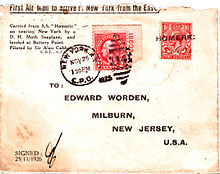- Alan Cobham
-
Sir Alan John Cobham, KBE, AFC (6 May 1894 –21 October 1973) was an English aviation pioneer.
A member of the Royal Flying Corps in World War I, Alan Cobham became famous as a pioneer of long distance aviation. After the war he became a test pilot for the de Havilland aircraft company, and was the first pilot for the newly formed de Havilland Aeroplane Hire Service. In 1921 he made a 5,000 mile air tour of Europe, visiting 17 cities in 3 weeks. In 1928 he flew a Short Singapore flying boat around the continent of Africa landing only in British territory. In August 1926, he flew from Britain to Australia where 60,000 people swarmed across the grassy fields of Essendon Airport, Melbourne when he landed his DH.50 float plane (it had been converted to a wheeled undercarriage earlier, at Darwin[1]). The return flight was undertaken over the same route. He was knighted the same year.
On 25 November 1926, Cobham attempted but failed to be the first person to deliver mail to New York City by air from the east, planning to fly mail from the White Star ocean liner RMS Homeric in a de Havilland DH.60 Moth floatplane when the ship was about 12 hours from New York harbour on a westbound crossing from Southampton. After the Moth was lowered from the ship, however, Cobham was unable to take off owing to rough water and had to be towed into port by the ship.
Also in 1926 Cobham was awarded the Gold Medal by the Fédération Aéronautique Internationale.[2]
In 1932 he started the National Aviation Day displays - a combination of barnstorming and joyriding. This consisted of a team of up to fourteen aircraft, ranging from single-seaters to modern airliners, and many skilled pilots. It toured the country, calling at hundreds of sites, some of them regular airfields and some just fields cleared for the occasion. Generally known as "Cobham's Flying Circus", it was hugely popular, giving thousands of people their first experience of flying, and bringing "air-mindedness" to the population. These continued until the end of the 1935 season.[3]
Cobham was also one of the founding directors of Airspeed Limited, the aircraft manufacturing company started by Nevil Shute Norway (perhaps better known as the famous novelist, Nevil Shute).
Norway, together with the designer Hessell Tiltman, having been discharged by the Airship Guarantee Company (a subsidiary of Vickers), after the R101 disaster also junked the more successful R100, decided to found their own small aircraft business: Cobham was an early and enthusiastic recruit: indeed, it was thanks to Sir Alan - who placed early orders for two "Off Plan" aircraft (the three-engined ten seater Ferry) for his National Aviation Day Limited company – that Airspeed managed to commence manufacturing at all.
Cobham's early experiments with in-flight refuelling were based on a specially adapted Airspeed Courier. This craft was eventually modified by Airspeed to Cobham's specification, for a non-stop flight from London to India, using in-flight refuelling to extend the plane's flight duration.
In 1935 he founded a small airline that flew from London Croydon Airport to the Channel Islands. Months later, after a crash that killed one of his pilots, he sold it to Olley Air Service Ltd and turned to the development of inflight refueling. Trials stopped at the outbreak of World War II until interest was successfully revived by the RAF and US Army Air Force in the last year of the war.
He once remarked: "It's a full time job being Alan Cobham!" He retired to the British Virgin Islands, but returned to England where he died in 1973.
The company he formed is still active in the aviation industry as Cobham plc.
As a child he attended Wilson's School,[4] then in Camberwell, London. The School relocated to the former site of Croydon Airport in 1975.
See also
- Aerofilms-the UK's first commercial aerial photography company
- His portrait (by Frank O. Salisbury, 1926, [1]) is in the National Portrait Gallery.
- Biography at Cobham Plc
- Round_the_Bend_(1951_novel) - the novel by Nevil Shute - features Cobham's National Aviation Day flying circus as an integral part of the plot.
- Philip Stenning, hero of Shute's Marazan is a character modelled upon Cobham and others
- The films 'With Cobham to the Cape' (1926), 'Round Africa with Cobham' (1928) and 'With Cobham to Kivu' (1932) are discussed by G.H. Pirie in 'Cinema and British imperial civil aviation, 1919–1939'. Historical Journal of Film, Radio and Television, 23 (2003), 117–131.
- On Cobham's (and other) air displays in Britain see Colin Cruddas' 2003 book Those Fabulous Flying Years (Air Britain, ISBN 0-85130-334-X).
- For discussion of Cobham's imperial air exploits see the 2006 book Highways to the Empire by Colin Cruddas (Air Britain, ISBN 0-85130-376-5), and Chapter 6 in G.H. Pirie, Air Empire: British Imperial Civil Aviation, 1919-39 (Manchester University Press, November 2009). 272pp. ISBN 978-0-7190-4111-2.
- Cobham published his own accounts of his Empire flights. A wider account of his life appeared in 1978 under the title A Time to Fly.
- On the motives for and impacts of Cobham's air circus in South Africa see G.H. Pirie 'South African air shows 1932/33: 'airmindedness', ambition and anxiety'. Kronos: Southern African Histories (2009), 48-70.
References
- ^ Wonders of World Aviation, Vol 10, 1938
- ^ United States. National Aeronautics and Space Administration; Emme, Eugene Morlock (1961). Aeronautics and astronautics; an American chronology of science and technology in the exploration of space, 1915-1960. pp. 175. http://www.archive.org/stream/aeronauticsastro61unit#page/174/mode/2up. Retrieved 3 June 2011.
- ^ Arthur Ord-Hume, Aeroplane Monthly, August 1973
- ^ Allport, D.H. & Friskney, N.J. "A Short History of Wilson's School", Wilson's School Charitable Trust, 1987
Categories:- 1894 births
- Old Wilsonians
- 1973 deaths
- English aviators
- Knights Commander of the Order of the British Empire
- Recipients of the Air Force Cross (United Kingdom)
- British test pilots
- Britannia Trophy winners
Wikimedia Foundation. 2010.

